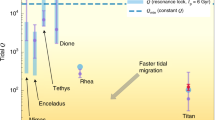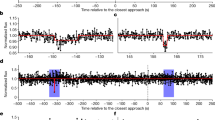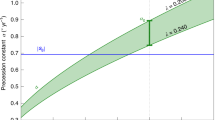Abstract
SOON after the discovery of the rings of Uranus1–3 it was suggested4 that the ring system might be determined by the perturbations of the satellite pairs Ariel–Titania and Ariel–Oberon. Aksnes5, and Goldreich and Nicholson6 have questioned this hypothesis; the latter showing that the strongest perturbations on the ring system can be expected to arise from the satellite pair Miranda-Ariel and the 4 : 1 resonance of Miranda. Goldreich and Nicholson also pointed out that the differences in the ring radii α–β, γ–δ and ε1–ε2 are known to a high degree of accuracy (typically ∼±15 km) which is considerably better than the absolute ring radii. My calculations of the separations of these ring pairs reported here suggest that the radii of the α and γ rings, and perhaps the ε1 and ε2 components as reported by Elliott et al.1, are governed by the resonances of Miranda and Ariel, with consistent further application of resonance theory to the location of the β and δ rings requiring the presence of an additional hypothetical satellite moving around Uranus. Without this hypothesis the observed ring system seems to be outside the scope of resonance theory alone.
This is a preview of subscription content, access via your institution
Access options
Subscribe to this journal
Receive 51 print issues and online access
$199.00 per year
only $3.90 per issue
Buy this article
- Purchase on Springer Link
- Instant access to full article PDF
Prices may be subject to local taxes which are calculated during checkout
Similar content being viewed by others
References
Elliot, J. L., Dunham, E. & Mink, D. Nature 267, 328–330 (1977).
Millis, R. L., Wasserman, L. H. & Birch, P. V. Nature 267, 330–331 (1977).
Bhattacharyya, J. C. & Kuppuswamy, K. Nature 267, 331–332 (1977).
Dermott, S. F. & Gold, T. Nature 267, 590–593 (1977).
Aksnes, K. Nature 269, 783 (1977).
Goldreich, P. & Nicholson, P. Nature 269, 783–785 (1977).
Ip, W.-H. Nature 272, 802–803 (1978).
Dermott, S. F. Nature Phys. Sci. 244, 18–21 (1973).
Marsden, B. G. IAU Circ. No. 3215 (1978).
Lucke, R. L. Nature 272, 148 (1978).
Hndbk Br. Astr. Ass. 1977.
Author information
Authors and Affiliations
Rights and permissions
About this article
Cite this article
STEIGMANN, G. Resonance orbits and the rings of Uranus. Nature 274, 454–455 (1978). https://doi.org/10.1038/274454a0
Received:
Accepted:
Issue Date:
DOI: https://doi.org/10.1038/274454a0
This article is cited by
-
Resonant structures in the solar system
The Moon and the Planets (1981)
-
Physical studies of the planetary rings
Space Science Reviews (1980)
-
On the Pioneer 11 observation of the ring of Jupiter
Nature (1979)
-
Formation of the regular satellite systems and rings of the major planets
The Moon and the Planets (1979)
Comments
By submitting a comment you agree to abide by our Terms and Community Guidelines. If you find something abusive or that does not comply with our terms or guidelines please flag it as inappropriate.



